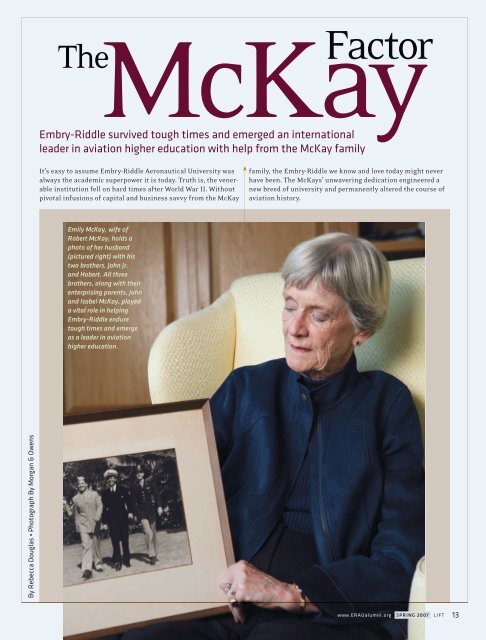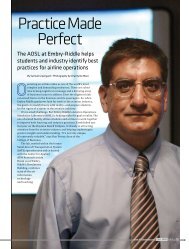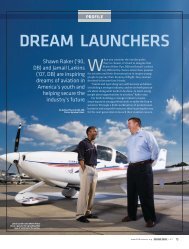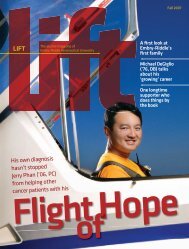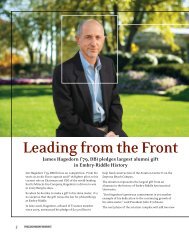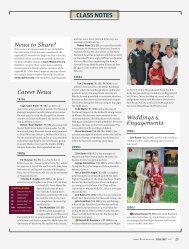Factor - Embry-Riddle Aeronautical University
Factor - Embry-Riddle Aeronautical University
Factor - Embry-Riddle Aeronautical University
You also want an ePaper? Increase the reach of your titles
YUMPU automatically turns print PDFs into web optimized ePapers that Google loves.
McKay<br />
The<br />
<strong>Factor</strong><br />
<strong>Embry</strong>-<strong>Riddle</strong> survived tough times and emerged an international<br />
leader in aviation higher education with help from the McKay family<br />
It’s easy to assume <strong>Embry</strong>-<strong>Riddle</strong> <strong>Aeronautical</strong> <strong>University</strong> was<br />
always the academic superpower it is today. Truth is, the venerable<br />
institution fell on hard times after World War II. Without<br />
pivotal infusions of capital and business savvy from the McKay<br />
family, the <strong>Embry</strong>-<strong>Riddle</strong> we know and love today might never<br />
have been. The McKays’ unwavering dedication engineered a<br />
new breed of university and permanently altered the course of<br />
aviation history.<br />
Emily McKay, wife of<br />
Robert McKay, holds a<br />
photo of her husband<br />
(pictured right) with his<br />
two brothers, John Jr.<br />
and Hobert. All three<br />
brothers, along with their<br />
enterprising parents, John<br />
and Isabel McKay, played<br />
a vital role in helping<br />
<strong>Embry</strong>-<strong>Riddle</strong> endure<br />
tough times and emerge<br />
as a leader in aviation<br />
higher education.<br />
By Rebecca Douglas • Photograph By Morgan & Owens<br />
www.ERAUalumni.org SPRING 2007 LIFT 13
PROFILE<br />
TAKING THE FIRST STEP<br />
They say timing is everything; once<br />
again, “they” are right. Even before the<br />
United States entered World War II, Miami<br />
lawyer John McKay and John Paul <strong>Riddle</strong><br />
anticipated big potential in the flight<br />
training business.<br />
After operating the <strong>Embry</strong>-<strong>Riddle</strong><br />
Company in Cincinnati with T. Higbee<br />
<strong>Embry</strong>, <strong>Riddle</strong> partnered with McKay in<br />
1939 to reopen <strong>Embry</strong>-<strong>Riddle</strong> in Miami.<br />
The two presumably became friends<br />
through their mutual interest in aviation.<br />
McKay was a WWI balloon pilot who<br />
always had an interest in flying; <strong>Riddle</strong><br />
kept three Piper Cub seaplanes along a<br />
causeway in Miami, where McKay lived.<br />
Foreseeing the United States’ direct<br />
involvement in the war, the duo worked<br />
to prepare <strong>Embry</strong>-<strong>Riddle</strong> for a civilian<br />
and military flight training boom. McKay,<br />
who later became known as the “business<br />
brains” of the team, focused on securing<br />
the necessary funds.<br />
“The big problem at that time was raising<br />
money to build airfields,” McKay’s son,<br />
Robert, explained as part of <strong>Embry</strong>-<strong>Riddle</strong>’s<br />
Heritage Project before his death in June<br />
2006. “The Army wanted the airfields, but<br />
they didn’t have the money because Congress<br />
hadn’t appropriated funds before December<br />
7 [of 1941, when the Japanese attack on Pearl<br />
Harbor prompted the United States to enter<br />
World War II].<br />
“If you raised money, the RFC—<br />
Reconstruction Finance Corporation—<br />
would lend money,” Robert explained.<br />
“That’s how they got the initial money to<br />
build [the airfields] and ground school<br />
operations for mechanical training.”<br />
THE NEXT GENERATION<br />
McKay’s three sons fulfilled a variety<br />
of roles during and after the<br />
war. The oldest, John Jr., served as<br />
an instrument flight instructor at<br />
<strong>Embry</strong>-<strong>Riddle</strong> and in later years<br />
presided as chairman of the board.<br />
He also delivered B-26 short-wing<br />
bombers to Egypt and flew DC-4s<br />
in South America on the Ferry<br />
Command as a civilian with Pan<br />
American Airways.<br />
Second-eldest son, Hobert<br />
Boomer, was a second lieutenant<br />
in the Reserves who flew B-29s<br />
and also instructed.<br />
Isabel McKay, the first woman to lead a<br />
major American flight school, used her<br />
“innate business ability” to keep <strong>Embry</strong>-<br />
<strong>Riddle</strong> aloft in a rough business climate<br />
after her husband, John, died.<br />
John McKay, who partnered with John<br />
Paul <strong>Riddle</strong> in 1939, led the effort to<br />
secure funds for <strong>Embry</strong>-<strong>Riddle</strong>, setting<br />
the stage for the school’s critical role in<br />
training pilots for the war.<br />
John McKay pins wings on his son, Robert.<br />
Robert, the youngest, enlisted in the<br />
Army Air Corps shortly after he turned 18.<br />
He had already earned his private pilot’s<br />
license at <strong>Embry</strong>-<strong>Riddle</strong>’s operation at<br />
Chapman Field off Biscayne Bay in Miami—<br />
flying as much as he could while home on<br />
vacation from prep school in Connecticut.<br />
“I lacked about 10 hours for my commercial<br />
license,” recalled Robert. “Perhaps I would<br />
have gone into the Army as a second lieutenant<br />
rather than a private if I had those<br />
10 hours.”<br />
Long after the war, Robert shared recollections<br />
of General Charles de Gaulle’s son,<br />
who served as a commandant of French<br />
Naval students at <strong>Embry</strong>-<strong>Riddle</strong>: “He was<br />
tall and thin and looked just like de Gaulle.<br />
He had the mustache and nose of de Gaulle.<br />
The only difference was he was more pompous<br />
than his father.”<br />
Robert also worked as an <strong>Embry</strong>-<strong>Riddle</strong><br />
dispatcher for 43 cents per hour. “It sounds<br />
low,” he admitted, “but you could buy a lot<br />
with 43 cents back in 1942.”<br />
Robert’s son, Rob McKay, researched his<br />
father’s military service for a college term<br />
paper. “It’s the most fun I’ve ever had writing<br />
a paper,” he notes. “It was great hearing<br />
about his B-17 missions in the European theater.<br />
He told stories I had never heard before<br />
about spraining his ankle in basic training<br />
and meeting Colonel Smith, who later flew a<br />
B-25 bomber into the Empire State Building.”<br />
Today, Rob McKay owns and operates<br />
Sylvania Airport, a two-runway private airport<br />
near Milwaukee.<br />
IN GOOD TIMES AND BAD<br />
As expected, business at <strong>Embry</strong>-<strong>Riddle</strong><br />
boomed during World War II. “The school<br />
exploded,” Robert said. “It grew very fast in<br />
a very short time.” In total, <strong>Embry</strong>-<strong>Riddle</strong><br />
trained approximately 25,000<br />
pilots and mechanics for the Allied<br />
Forces. (See sidebar on page 15.)<br />
After the war, however, demand<br />
for flight and technical training<br />
dropped dramatically. In 1944,<br />
<strong>Riddle</strong> developed a branch of the<br />
school in Brazil, while John McKay<br />
headed operations stateside. When<br />
McKay died in 1951, his wife,<br />
Isabel McKay, succeeded him—<br />
during extremely tough business<br />
conditions. Their son, John Jr.,<br />
served a short term as interim<br />
president in between.<br />
14 LIFT SPRING 2007 www.ERAUalumni.org
“It was very questionable whether the school would continue,”<br />
Robert recalled. “The company was losing money hand over fist.”<br />
Recruiting students and collecting tuition payments were<br />
recurrent challenges—especially before the GI Bill was in effect.<br />
“My mother worked very hard to keep it going,” Robert recalled.<br />
“She had an innate business ability…She was very personable—as<br />
was my father.”<br />
Interestingly, the woman who made history as the first female<br />
to head a major American flight school never held a pilot’s license.<br />
“She took a couple lessons,” laughed Robert, who vividly recalled<br />
the one ride she gave him in a Piper Cub:<br />
“We landed—I don’t know how—and I went back by the tail<br />
and vomited. I was so scared of her flying! She never tried to fly<br />
since then.”<br />
After the war, Robert studied aeronautical engineering at<br />
Princeton, then went to law school at the <strong>University</strong> of Virginia.<br />
Working as a patent examiner for the U.S. Patent Office in<br />
Washington, D.C., provided the experience and expertise necessary<br />
to later become a partner at Pennie & Edmonds in<br />
New York, one of the country’s most prestigious intellectual<br />
property practices.<br />
John Jr. and Hobert McKay stayed in the Miami area—“Jack”<br />
as a lawyer, “Hobie” with the bus company.<br />
After Isabel McKay suffered a minor stroke around 1961, the<br />
McKay brothers urged their mother to follow doctors’ instructions<br />
to reduce her stress level. Fortunately, she admired the<br />
business vision of Jack Hunt enough to retire. The family sold<br />
the school, and Hunt officially became president in 1963.<br />
The influence of the McKay family, however, can still be felt<br />
throughout ERAU. In the late 1980s, students memorialized<br />
Isabel McKay, when they voted to name a Daytona Beach residence<br />
hall after her.<br />
After Robert McKay concluded his service on the board of<br />
directors, he remained a generous financial supporter.<br />
“He was always terribly interested in <strong>Embry</strong>-<strong>Riddle</strong>,” notes<br />
Robert’s wife, Emily McKay. “He was proud of what his parents<br />
did for the school and was happy with what it had become. Out<br />
of loyalty to them, he continued supporting the school after the<br />
family sold it.”<br />
During a visit to <strong>Embry</strong>-<strong>Riddle</strong> in 2004, just 18 months before<br />
he died, Robert McKay marveled at its size and scope.<br />
“I had no idea it would survive and grow to become the institution<br />
that it is today,” he noted. “I’m just sorry that my mother and father<br />
can’t see it.”<br />
The British Are Coming<br />
When The Beatles landed here<br />
in 1964, it was actually the second<br />
British invasion. The first<br />
was when thousands of Royal<br />
Air Force cadets came to train<br />
for World War II at American<br />
facilities such as <strong>Riddle</strong> Field<br />
in Clewiston, Fla.<br />
“The United States hadn’t entered the war yet, so we were a<br />
safe place with good weather to train fighter and bomber pilots,”<br />
explains Daytona Beach professor Stephen Craft, Ph.D.<br />
As one of seven civilian contractors, <strong>Embry</strong>-<strong>Riddle</strong> provided<br />
primary training on Stearman PT-17 biplanes and eventually<br />
advance training on AT-6 Harvards.<br />
After the war, John Paul <strong>Riddle</strong> and John McKay were both<br />
made members of the Most Excellent Order of the British Empire<br />
in recognition of the school’s service.<br />
Ensuring that RAF pilots were trained “the British way” was of<br />
paramount importance. “They sent out a lot of directives regarding<br />
specific elements of training,” Dr. Craft explains. “They placed<br />
a greater emphasis on instrument training and low-level flying<br />
[around 500 feet]. They also did a lot more night flying than the<br />
U.S. Army Air Forces.<br />
“British bombers primarily attacked at night; their pilots came<br />
out of training at <strong>Embry</strong>-<strong>Riddle</strong> well-prepared for that kind of<br />
combat. It was dangerous, though. A number of cadets were killed<br />
on day and nighttime cross-country training flights,” he says.<br />
Dr. Craft’s research in London and interviews with surviving<br />
instructors and students revealed another main difference: RAF’s<br />
strict anti-hazing policies. “They were absolutely incensed by it,”<br />
he notes.<br />
Robert McKay, whose father partnered with John Paul <strong>Riddle</strong><br />
to expand <strong>Embry</strong>-<strong>Riddle</strong> for wartime training, personally kept in<br />
touch with many of the school’s British flight students decades<br />
later, including John Potter, president of the No.5 British Flight<br />
Training School (No. 5 BFTS).<br />
www.ERAUalumni.org SPRING 2007 LIFT 15


